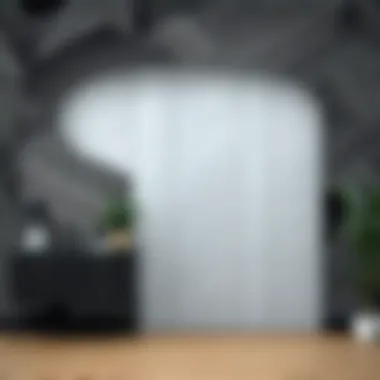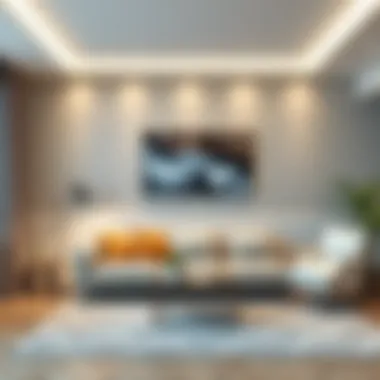Transforming Spaces with Wall Panels and Peel and Stick Wallpaper


Intro
Creating inviting and functional living spaces is an art in itself. With the advent of wall panels and peel and stick wallpaper, the narrative of interior design has taken a noteworthy turn. These elements allow for a significant transformation without necessarily breaking the bank or requiring professional help. Understanding how to leverage these solutions can not only uplift aesthetics but also enhance everyday practicality.
Wall panels bring a remarkable authenticity to any setup, serving as both decorative and functional aspects of a room. They can act as sound barriers and insulation while providing a touch of elegance. On the other hand, peel and stick wallpaper offers flexibility and creativity, letting individuals express their tastes easily. The simplicity of installation caters to both seasoned designers and do-it-yourself homeowners alike.
Practical Applications
In essence, the versatility of these elements can be seen in various spaces:
- Residential Use: From accent walls in bedrooms to splashbacks in kitchens, they serve distinctive roles.
- Commercial Spaces: Restaurants and offices utilize these for branding and creating inviting atmospheres.
- Event Settings: Temporary installations can make a large impact for weddings and corporate events.
By examining the features, benefits, and installation processes, we delve deeper into this remarkable world. In addition, it’s crucial to consider durability, sustainability, and maintenance, which solidify these choices as not just aesthetic but also practical solutions in contemporary design.
Understanding these dimensions can guide homeowners and design enthusiasts toward making informed decisions. Let’s explore how wall panels and peel and stick wallpaper can truly transform spaces.
Understanding Wall Panels
In the journey of enhancing interior spaces, wall panels stand out as a transformative element. They are not merely about aesthetics; they contribute to the overall functionality and atmosphere of a room. Knowing what wall panels are, their material options, and why they matter in contemporary design cannot be understated. This section will focus on several aspects, including materials, benefits, and distinct use cases, all of which illustrate the critical role that wall panels play in today's stylish environments.
Definition and Material Options
Wood Panels
Wood panels are a classic choice in interior design, valued for their authentic look and feel. Made from various types of wood, they offer a natural warmth that can make a space feel cozy and inviting.
A standout feature of wood panels is their sustainability; they can be sourced from eco-friendly timber. Their durability is another point in their favor. However, maintenance is essential, as wood requires periodic treatment to prevent damage from moisture or pests.
In this article, wood panels can serve as an example of a luxury finish that is still approachable for the average homeowner, making it a popular choice.
Composite Materials
Composite materials bring a mix of durability and aesthetic appeal. Combining wood fibers with resins, these panels can mimic the look of real wood while often being more resistant to wear and tear.
Their cost-effectiveness is a prime reason for their popularity. Homeowners can enjoy a stylish appearance at a fraction of the price of solid wood. However, some may argue that they lack the unique grain patterns found in natural wood, which can be disappointing for those who value authenticity.
Textured Panels
Textured panels add depth and interest to flat surfaces. Whether they simulate brick, stone, or elaborate designs, their tactile quality often catches the eye.
These panels are versatile and can be painted or stained, allowing homeowners to customize their appearance. However, one must consider their cleaning requirements, as textured surfaces can accumulate dirt more easily, potentially requiring more effort to maintain.
PVC Panels
PVC panels are known for their waterproof qualities, making them ideal for spaces like bathrooms and kitchens. Unlike natural materials, they won't be affected by humidity, and they are generally resistant to fading.
Their light weight contributes to an easy installation process, often not needing a professional setup. On the downside, the aesthetic appeal might not hold up to wooden or composite alternatives, potentially limiting their use in high-end designs.
Historical Context of Wall Panels
Evolution of Design Trends
The evolution of wall panels over the years reflects changes in societal tastes and building practices. From the elegant wood paneling of earlier periods to sleek modern styles, panels have adapted to the whims of fashion while still retaining their core benefits.
One key characteristic is that they often echo the architectural significance of their times. Be it decorative plaster in the past or minimalist designs today, these trends indicate a shift in values—moving from extravagance to simplicity.
Traditional vs. Modern Use
In traditional settings, wall panels were crafted for specific rooms, maintaining an air of distinction and formality. Nowadays, contemporary interiors have democratized their use; they can be found in every room of the house, blending utility with modern aesthetics.
This versatility is beneficial for anyone looking to freshen up their living spaces—they are no longer limited to formal spaces but are instead celebrated in casual environments.
Cultural Influences
The cultural background of wall panels speaks volumes about the values and practices of different societies. For example, Japanese usuage of wood panels reflects a minimalist ethos focusing on harmony with nature, while Western styles often lean towards decorative embellishments.
These influences provide insight into regional preferences and materials, reminding us that design is not only functional but also deeply embedded in cultural narratives.
Advantages of Wall Panels
Insulation Properties
Wall panels offer added insulation, improving a home's energy efficiency. This advantage means lower heating and cooling costs, a fact that appeals to environmentally conscious consumers.
Furthermore, some panels, like those made from composite materials, can significantly mute sound, providing an extra layer of comfort in busy homes.


Ease of Installation
The installation process for wall panels can vary, but many options are designed for DIY enthusiasts. Their simple fixing methods allow even inexperienced homeowners to achieve professional-looking results.
This ease of application can make them an appealing choice for those looking to undertake home improvement projects without hiring outside help.
Durability and Maintenance
Durability is a hallmark feature of wall panels across all materials. Most panels tend to withstand daily wear and tear better than traditional paint or wallpaper, leading to prolonged usage with minimal maintenance.
Though natural materials might need regular treatment, innovations in composite and PVC options have enhanced longevity significantly. This simple, low-maintenance approach is a key selling point when making decor decisions.
Versatile Design Options
The variety in styles, textures, and materials means wall panels can suit just about any design ethos. From rustic cabin vibes with wood to sleek minimalism with PVC, there’s a panel option out there for everyone.
This design adaptability allows homeowners to reflect their personal style regardless of trends, making them a long-term solution for aesthetic appeal.
Ideal Use Cases for Wall Panels
Residential Applications
Within residential settings, wall panels can breathe new life into rooms that feel dated. Feature walls are a popular approach, adding depth and focus at a fraction of the cost of a full remodel.
Using wall panels creatively helps make a personal mark on a home while still providing structural benefits, making them a real win-win for interior decorators.
Commercial Spaces
In commercial settings like offices and restaurants, wall panels can provide professional aesthetics while also serving practical purposes like sound dampening.
The durability of panels means they can withstand high traffic without losing their visual appeal, making them economically sound investments for businesses.
Creative Installations
For those looking to step outside the box, wall panels offer limitless creative potential. Whether used as backdrops for displays or in artistic arrangements in exhibitions, their functional and aesthetic versatility makes them a valuable tool in creative projects.
Designers and artists can experiment with patterns, layering, and finishes, leading to unique installations that challenge conventional design principles.
The Rise of Peel and Stick Wallpaper
Peel and stick wallpaper has carved out its own niche within the dynamic world of interior design. Its surge in popularity reflects a blend of practicality and aesthetics, offering solutions that suit various lifestyles and tastes. This section delves into the aspects that elevate peel and stick wallpaper as a compelling choice for wall decoration, showcasing its features, advantages, and the ease with which it fits into modern living.
Definition and Key Features
Material Composition
Peel and stick wallpaper generally consists of vinyl. This material is notable for its durability and moisture resistance, making it an ideal choice in areas like kitchens and bathrooms. The key characteristic of vinyl is its smooth surface, which allows for easy cleaning and maintenance. One unique feature of this material is its ability to mimic the appearance of other textures, such as wood or fabric, without the associated care requirements. While its convenience is a major draw, potential downsides may include limited breathability, which can affect indoor air quality in tightly sealed rooms.
Adhesive Technology
The adhesive backing is a significant aspect of peel and stick wallpaper. It employs a repositionable adhesive—which adheres well without damaging walls—allowing users to install and adjust panels easily. This characteristic makes it particularly appealing for renters or those who frequently redecorate. One drawback, however, is that the adhesive may lose its potency over time or under extreme conditions, which could lead to peeling edges. Consequently, understanding how this technology works is crucial for anyone considering its use.
Variety of Designs
One of the most appealing aspects of peel and stick wallpaper is the extensive variety of designs available. From bold florals to minimalist geometrics, there are options to fit virtually any decor style. This variety allows for personal expression while offering designers and homeowners the flexibility to adapt spaces with changing trends. However, while the multitude of choices enhances the design experience, it may also be overwhelming. Selecting the right pattern requires careful consideration of how it complements existing elements in a space.
Benefits of Peel and Stick Wallpaper
Temporary Solutions for Renters
For many renters, decorating can pose challenges due to restrictions on paint or permanent fixtures. Peel and stick wallpaper provides an excellent, non-invasive solution that can be easily removed upon lease termination. This feature allows tenants to express their style without undergoing extensive renovations or facing potential penalties for wall damage. While this option is extremely beneficial, some designs may not hold up as well as others, especially in high-traffic areas or during transitions between seasons.
Child-Friendly Options
Families with young children often need designs that withstand wear and tear. Many peel and stick wallpaper brands offer child-friendly options, which not only elevate the aesthetic of a room but also inspire creativity. The ability to change wallpapers as children's interests evolve offers versatility that traditional methods simply can't match. Nonetheless, it’s crucial to check if the wallpaper is free from harmful chemicals to ensure safety in a child’s environment.
Cost-Effectiveness
Affordability is another selling point for peel and stick wallpaper. Compared to traditional wallpaper or paint jobs, the cost associated with purchasing and installing peel and stick options tends to be lower, particularly when factoring in installation fees. This cost-effectiveness makes peel and stick wallpaper an attractive choice for budget-conscious individuals looking to revamp their spaces without breaking the bank. However, it’s worth noting that prices can vary significantly depending on design and brand, so shoppers should keep an eye out for deals or quality alternatives.
Installation Process
Surface Preparation
Preparing the surface is vital to ensure a smooth installation of peel and stick wallpaper. The surface should be clean, dry, and free from imperfections, as any bumps or dirt could affect adhesion. This preparation phase helps achieve a seamless finish and increases the longevity of the wallpaper. Failure to properly prepare the walls can lead to unsightly bubbles or peeling, potentially causing a headache for the user down the line.
Application Techniques


When applying peel and stick wallpaper, taking it slow is essential. Starting at the top and working your way down can help minimize errors. Smooth out air bubbles as you go to ensure a clean application. This technique enhances the overall appearance and can make for a more satisfying DIY experience. However, intricate patterns may require extra attention to aligning edges, which could lead to frustration if not approached carefully.
Removing and Repositioning
One substantial advantage of peel and stick wallpaper is its reusability. Users can remove and reposition it without damaging walls, making it an ideal choice for those unsure about longstanding installations. This process allows for experimentation with different designs and arrangements, thus fostering creativity in home decor. Keep in mind that repeated repositioning might diminish the adhesive strength, leading to possible reapplication.
Environmental Considerations
Sustainability in Production
With an increasing focus on environmental consciousness, peel and stick wallpaper is emerging with more sustainable production methods. Many manufacturers now use eco-friendly materials and processes, aiming to reduce waste and environmental impact. This trend has made peel and stick wallpaper a more compelling choice for eco-minded consumers, who want beautiful interiors without compromising their values. However, not all products may be created equal, so thorough research into brands' sustainability practices is necessary.
Recyclability
Another environmental factor worth noting is the recyclability of peel and stick wallpaper. While traditional paper-based wallpapers may be recyclable, the plastic components can complicate disposal. It's essential for consumers to research whether their selected wallpaper can be recycled and to follow proper disposal techniques accordingly. This knowledge contributes to responsible consumption and supports broader environmental goals, encouraging an eco-friendly approach to interior design.
Health Impacts
Finally, considering the health impacts of materials is crucial for overall home wellbeing. Some peel and stick wallpapers are designed to be low-VOC, promoting healthier indoor air quality, while others may contain chemicals that can release harmful emissions. Homeowners should prioritize products that provide good airflow and minimize health risks, ensuring safe living spaces, especially for children or individuals with sensitivities. Being knowledgeable about these characteristics can help to make informed decisions when selecting wall coverings.
Combining Wall Panels with Peel and Stick Wallpaper
Combining wall panels with peel and stick wallpaper has become a popular trend among homeowners and designers. This union allows for greater freedom in creating visually stunning and highly functional spaces. While both elements serve to enhance the aesthetics of an area, their integration can offer a synergy that maximizes their individual benefits. From revitalizing a dull room to providing structural soundness, the possibilities are endless. Moreover, the blend of textures and patterns encourages creativity, making every space feel truly unique.
Design Harmonization
Color Coordination
Color coordination is about more than just picking shades that look good together. It's about creating a harmonious visual experience that resonates with one's personal style. When you match wall panels with peel and stick wallpaper, you can achieve a balanced palette that draws the eye through the room.
One key characteristic of effective color coordination is that it enhances the natural light in a space. Light colors can make small rooms feel more open, while darker hues can add coziness. A noteworthy feature of this practice is that it allows for deliberate play on themes, where one can choose complementary colors that echo throughout the space.
However, it’s crucial to tread carefully; overly bold colors can clash, and you may end up with an eyesore instead of a masterpiece.
Pattern Mixing
Pattern mixing is akin to a dance; when done right, it creates a rhythm throughout your decor that adds dimension and interest. This art of layering patterns from wall panels to wallpapers can provide a rich storytelling element in any room.
When opting for pattern mixing, it��’s important to consider scale and complexity. A large-scale wall panel design paired with smaller, more intricate wallpaper patterns can strike a balance that keeps the eye engaged. Although this approach allows for a highly personalized ambiance, it can be a double-edged sword. If patterns are too similar or overly chaotic, the result can veer off into visual disarray.
Texture Contrast
Texture contrast creates depth and organizes tactile elements within a design scheme. Using materials such as smooth, glossy panels next to the tactile nature of textured wallpapers can create a striking visual effect.
A unique feature of texture contrast is how it can affect the mood of a space. For instance, matte finishes can evoke a cozy feeling while glossy surfaces may add modernity. The balanced interplay not only draws sight but also encourages touch, enhancing the overall sensory experience. On the flip side, mixing too many textures without any cohesive theme can create confusion, leaving one wondering what the intended design vision actually is.
Practical Applications
Feature Walls
Feature walls can act as focal points in a room, drawing attention to a particular area or item. They serve to break the monotony of flat surfaces, providing an engaging element that anchors the overall design.
One strong characteristic of feature walls is their ability to express personality. Using a bold peel and stick design alongside a sturdy wooden panel creates a dramatic statement that can make any room feel more alive. This blend not only enhances aesthetics, but can also elevate the perceived value of the home. Yet, there’s a risk: if the feature wall becomes cluttered or competes with other decor elements, the intent can be lost.
Accent Areas
Accent areas are small sections of a room that can pack a punch without overwhelming the entire space. By carefully selecting a combination of wall panels and peel and stick wallpaper, you can perfectly emphasize areas like niches, door frames, or even sections of a ceiling.
The benefit of accent areas lies in their simplicity. Properly executed, they create visual interest without requiring a total revamp of the room. However, it's vital to avoid making these areas too loud, risking them becoming a distraction rather than an enhancement.
Spatial Separation
Using wall panels and peel and stick wallpaper for spatial separation offers a modern twist to traditional room dividers. This technique is especially useful in open concept layouts, where you want to create distinct zones without permanent walls.
One of the attractive qualities of this approach is adaptability; as needs change, so can the layout. Elegant panels can delineate spaces while stylish wallpaper adds an individualized touch. Nevertheless, one must remain cautious; if not done thoughtfully, this method can create a fragmented look that disrupts the flow of a room.
"The right combination can not only beautify a space but also elevate the living experience to new heights."
Integrating wall panels with peel and stick wallpaper offers myriad opportunities to redefine spaces while weaving together different stylistic elements. By understanding the nuances of design harmonization and practical applications, you can create environments that are not only visually stimulating but also deeply personalized.
Maintenance and Care
Maintaining and caring for wall panels and peel and stick wallpaper is more than just a chore; it’s an art that ensures the longevity and aesthetic appeal of your space. Understanding the proper cleaning techniques and routine maintenance steps can greatly enhance the durability of these materials, ensuring they continue to impress for years to come. As with any decorative element in your home, proper care can also prevent unforeseen damage and costly replacements down the line.
Cleaning Techniques for Wall Panels
Safe Cleaning Agents


Using safe cleaning agents is a crucial aspect of maintaining wall panels. The right products can prevent damage while keeping your materials looking sharp. A key characteristic of these agents is their non-toxic nature. This makes them ideal for households with children or pets, as a safe environment is paramount. Typical products include mild soap solutions, vinegar mixes, and specially formulated cleaners designed for wood or composite materials.
One unique feature of these safe agents is their gentle, yet effective cleaning capabilities. While they may not tackle some stubborn stains as aggressively as harsher chemical cleaners, their advantage lies in protecting the integrity of the material. Avoid abrasives and heavy-duty solvents that can diminish the finish.
Regular Maintenance Routines
Incorporating regular maintenance routines can significantly extend the life and appearance of wall panels. One characteristic of these routines is their simplicity. Basic tasks like dusting, wiping surfaces with a damp cloth, and checking for damage should be conducted routinely, typically every few months or so. This not only keeps the panels looking fresh but also allows for the early detection of issues.
What sets regular maintenance apart is its preventive quality. By routinely cleaning and checking for minor damages, you can avoid larger repairs or replacements. It may seem tedious, but this practice becomes second nature and proves beneficial over time.
Caring for Peel and Stick Wallpaper
Spot Cleaning
Spot cleaning is essential in maintaining the freshly applied look of peel and stick wallpaper. This technique often involves using a damp cloth and a mild cleaner specifically designed for wallpapers. The key characteristic of spot cleaning is its focus on targeted areas, which is especially useful for removing scuffs and stains without needing to remove the entire panel.
The unique feature of spot cleaning is its convenience. In just a few minutes, you can refresh a wall without significant effort. However, be cautious with water usage; too much moisture can compromise the adhesive. This method is widely considered a popular choice, especially in high-traffic areas where marks and scrapes are likely.
Dealing with Peeling Edges
Peeling edges can be a nuisance, but they are also an easily manageable issue. This characteristic of peel and stick wallpaper arises from the adhesive losing its grip over time. Effective strategies include carefully pressing the edges down with a flat object or applying additional adhesive specifically made for wallpaper.
The unique aspect of addressing peeling edges lies in its immediacy. Quick intervention can prevent the peel from spreading, maintaining the wall's overall appearance. However, over-reliance on extra adhesive could lead to complications, especially if the original adhesive is still working effectively. Finding a balance is essential for ensuring a durable, beautiful finish.
Regular maintenance and careful cleaning are not just chores; they're investments into the look and lifespan of your interior spaces.
Trends and Innovations
The landscape of interior design is evolving swiftly with trends and innovations that define how we think about wall decor. In the era of personalized spaces, wall panels and peel and stick wallpaper have broadened the horizons for creativity and functionality. These innovations not only cater to aesthetic preferences but also address the practical needs of modern living. This section dissects emerging patterns, textures, and technological advancements that are captivating fashion enthusiasts and designers alike.
Emerging Patterns and Textures
Natural Aesthetics
Natural aesthetics focuses on incorporating elements that mimic the beauty of nature. This theme has gained traction due to its soothing feel and ability to forge a connection between indoors and outdoors. A key characteristic of natural aesthetics is the use of earthy tones and organic textures that create a calm atmosphere.
One unique feature of this style is the use of faux wood or stone wall panels which can be remarkably realistic or peel and stick wallpapers that depict lush landscapes or botanical motifs. The advantage here lies in their ability to transform a space, providing it a warm, inviting effect, which is crucial for areas like living rooms or bedrooms. However, one must be wary of trends shifting too fast, as some might see these natural looks as fleeting rather than timeless.
Geometric Designs
Geometric designs have taken a front seat in the trend wagon, offering bold patterns that inject dynamism and modernity into spaces. The appeal of geometric patterns often lies in their versatility, as they can vary from symmetrical shapes to more abstract forms. This makes them suitable for various design concepts, whether you are after a minimalist look or something more eclectic.
The standout feature of geometric designs is their ability to create visual interest without overwhelming a space. They work wonders in small areas, cleverly drawing the eye upward or around. Nevertheless, while these patterns are popular for accent walls, they can sometimes clash with simpler, softer decor, which means a careful balancing act is necessary.
Technological Advancements in Materials
Smart Wallpapers
Smart wallpapers represent the future of wall decor. These high-tech coverings often incorporate sensors or lighting elements, allowing them to adapt to the environment. For example, some smart wallpapers can change colors or patterns in response to changes in light or temperature, creating a space that feels alive and dynamic.
The key characteristic of smart wallpapers is their interactive nature. They offer both practical and aesthetic benefits, making them an attractive choice for tech aficionados and design lovers alike. However, one must consider the complexity of installation and potential maintenance issues since these products often require special care.
Eco-Friendly Developments
With a growing awareness of environmental impact, eco-friendly developments in wall decor have become increasingly prevalent. This movement emphasizes the use of sustainable materials and production methods. Many manufacturers are now producing wall panels and peel and stick wallpapers that are made from recycled products or sustainably sourced materials.
A distinctive feature of eco-friendly wall decor is its contribution to reducing carbon footprints. These products often feature low VOC (volatile organic compounds), ensuring a healthier indoor environment. While the upfront cost might be higher, the long-term benefits—both environmentally and health-wise—are significant, making this option appealing for conscientious consumers.
Final Thoughts
The discussion about wall panels and peel and stick wallpaper isn't simply about aesthetics; it's about how these elements can meaningfully change a space. Their versatility highlights the endless possibilities in interior design. This section pulls together the essential takeaways from previous discussions, emphasizing critical decisions every homeowner or designer may need to tackle.
Choosing the Right Option
Assessing Personal Style
Tailoring your wall décor to reflect personal style is paramount. It’s not just about what’s currently fashionable; it’s about what resonates personally in your living environment. A unique characteristic of assessing personal style involves evaluating how colors, textures, and patterns influence emotion and perception within a space. For instance, a person who favor pastels might lean toward softer, more tranquil peel and stick options to cultivate a serene atmosphere, while someone targeting a more robust tone might opt for bolder wall panels.
The advantages of this personal approach are clear. Personalization can amplify one’s enjoyment of a space while also increasing property value by creating a tailored aesthetic that potential buyers can appreciate. However, it can be a double-edged sword—what’s trendy today might not be tomorrow, leading to potential regrets in the long haul when styles evolve.
Budget Considerations
Making aesthetic choices often hinges on budget constraints. Understanding the financial aspect of selecting either wall panels or peel and stick wallpaper helps in making informed decisions without overshooting expectations. A critical character of budget considerations centers on the longevity of investment. Wall panels, while sometimes pricier upfront, can offer durability and a long lifespan, making them economical in the long-term view. In contrast, peel and stick wallpaper may appeal to tighter budgets due to lower costs and the ease of updating styles with little financial burden.
A unique feature here is how both options can cater to various budget ranges. For example, clever sales on high-quality wall panels can sometimes match or even undercut their wallpaper counterparts over time, especially if the wallpaper requires replacements more frequently. Hence, an in-depth analysis of potential costs ensures smarter choices in design decisions.
Future of Wall Decor
Integrating New Technologies
The evolution of materials, such as smart wallpapers that interact with light or climate, stands as a hallmark of integrating new technologies into wall decor. This trend is immensely beneficial for anyone looking to combine innovation with aesthetics. These materials can adapt based on weather conditions or time of day, reflecting a modern understanding of sustainability and resource efficiency.
Such advancements significantly enhance the quality of living spaces, merging functionality with beauty. Not only can these materials regulate temperature but they also contribute to energy efficiency, potentially lowering utility costs. However, the flip side might be the initial investment required to adopt such technologies, which may not fit every budget or preference.
Adapting to Changing Aesthetics
In a world where tastes and trends ripple through design circles like waves in the ocean, adapting to changing aesthetics is crucial. Designers and homeowners alike must remain astute to the shifts in styles—whether leaning toward minimalism or a return to bohemian charm. The ability to embrace these changes might have the biggest impact on retaining or experiencing joy in a space over time, injecting freshness when needed.
One significant benefit of this adaptability is the ability to redefine spaces easily. Through removable wall coverings, shifts in aesthetics can feel less monumental, allowing an environment to evolve with the individual’s tastes. However, keeping pace with trends might incur costs of continuous purchases or renovations, which savvy designers and homeowners need to consider.
Exploring the capabilities of wall panels and peel and stick wallpaper opens up a realm of creative possibilities that extend far beyond mere-décor solutions. By weighing personal style, budget considerations, and future decor potentials, everyone has the tools to create spaces that are not only beautiful but also comfortable and reflective of individual tastes.



